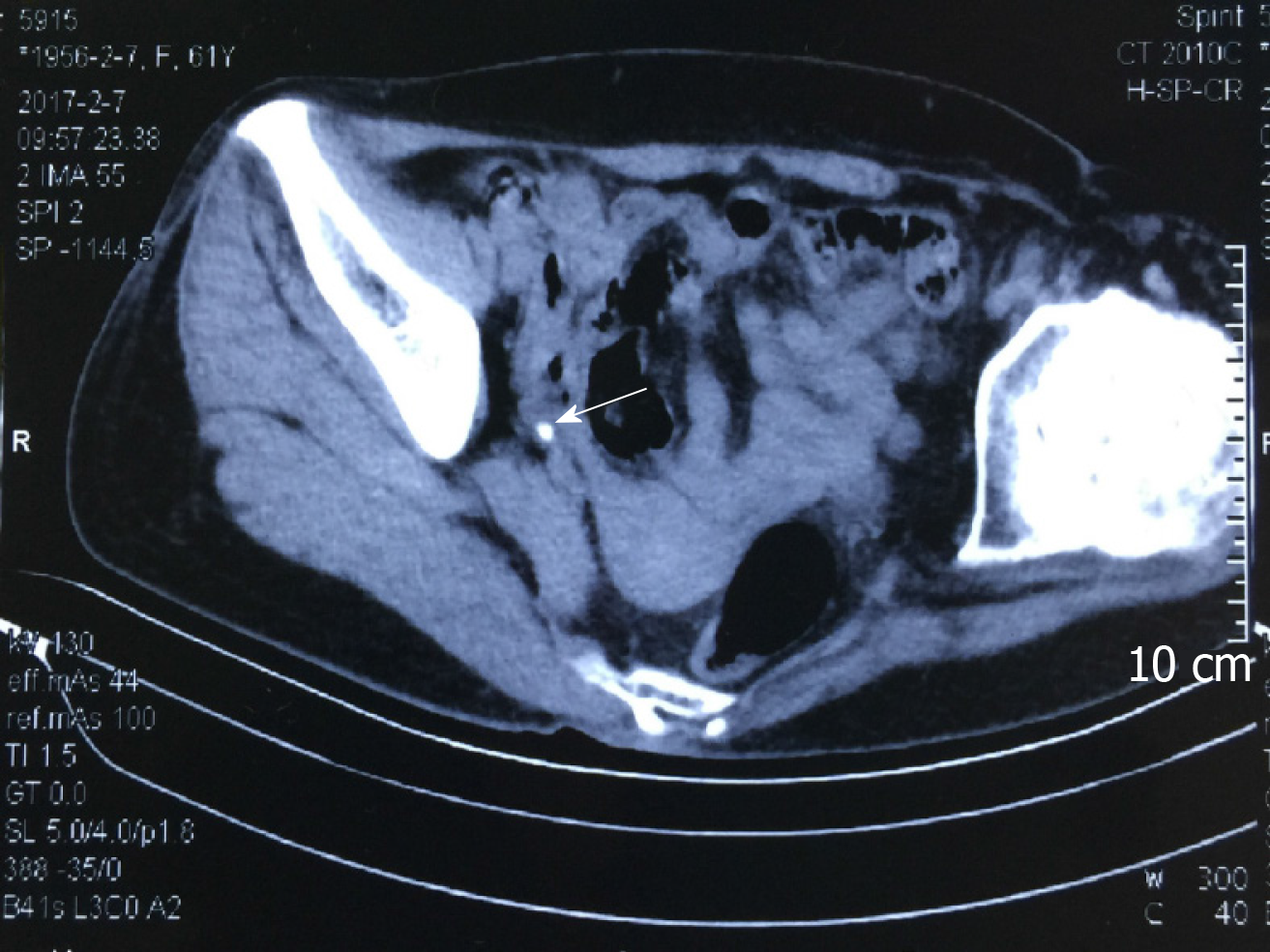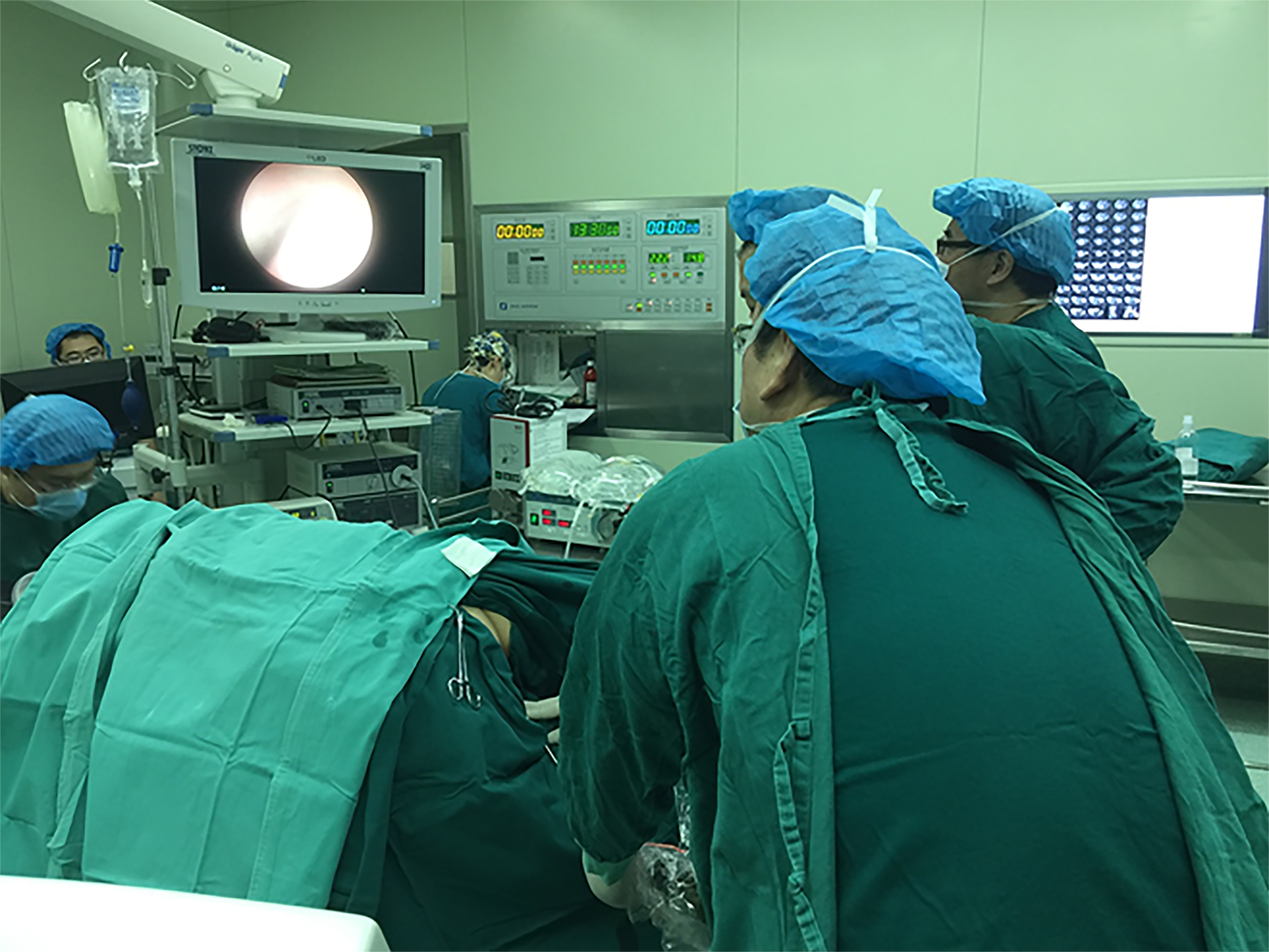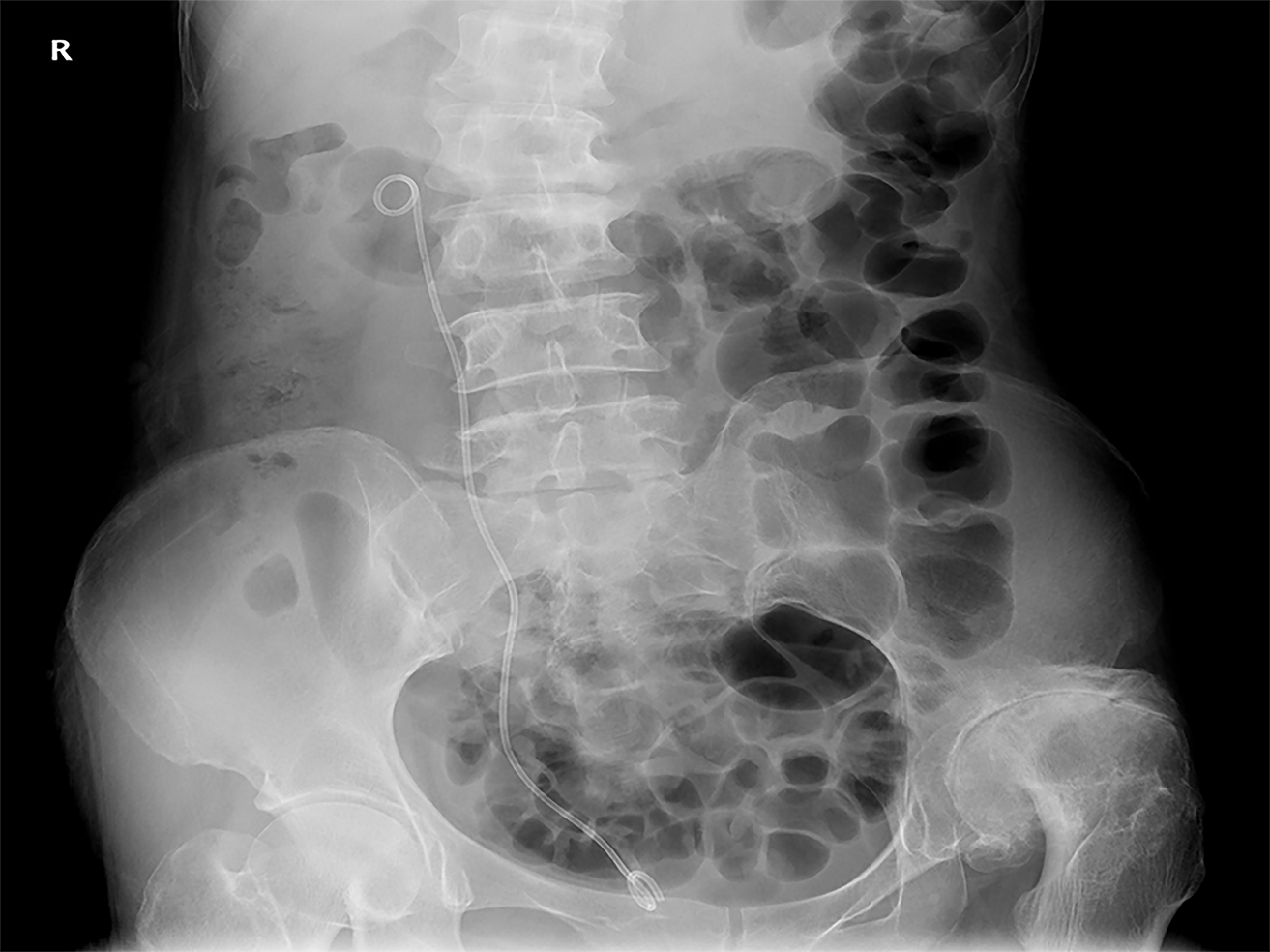Published online Apr 6, 2020. doi: 10.12998/wjcc.v8.i7.1301
Peer-review started: October 24, 2019
First decision: January 17, 2020
Revised: January 18, 2020
Accepted: March 5, 2020
Article in press: March 5, 2020
Published online: April 6, 2020
Processing time: 164 Days and 19.3 Hours
Ureteroscopy is widely used in the treatment of ureteral stones due to the increased morbidity of urolithiasis. This is the first report of a case of ureteral calculi treated with rigid ureteroscopy in the modified prone split-leg position.
A 62-year-old Asian woman was diagnosed with a ureteral stone and underwent extracorporeal shock wave lithotripsy twice. However, the abdominal computer tomography scan showed persistent calculi on the right lower ureter. Her left hip movement was limited because of a left femoral neck fracture that did not receive proper treatment in a timely manner. She was unable to undergo surgery in the lithotomy position and refused to accept flexible ureteroscopy treatment. Therefore, rigid ureteroscopy was performed with her in the modified prone split-leg position. The ureteral calculi were successfully fragmented.
It is feasible to treat lower ureteral calculi in women in the prone split-leg position with the implementation of rigid ureteroscopy.
Core tip: Ureteroscopy is widely used in the treatment of ureteral stones due to the increased morbidity of urolithiasis. In some special cases, ureteroscopic surgery cannot be performed by conventional positioning. This is the first report about a case of ureteral calculi treated with rigid ureteroscopy in a modified prone split-leg position. Due to the patient's hip disease, she was unable to undergo surgery in the lithotomy position. In this case, we successfully fragmented the ureteral stone. We think it is feasible to treat lower ureteral calculies in woman in the prone split-leg position with the implementation of rigid ureteroscopy.
- Citation: Huang K. Rigid ureteroscopy in prone split-leg position for fragmentation of female ureteral stones: A case report. World J Clin Cases 2020; 8(7): 1301-1305
- URL: https://www.wjgnet.com/2307-8960/full/v8/i7/1301.htm
- DOI: https://dx.doi.org/10.12998/wjcc.v8.i7.1301
In recent decades, ureteroscopic lithotripsy has become the main therapy to treat urolithiasis[1], with reduced expenditure and higher efficiency. Most ureteroscopy is performed effectively and safely in the supine position. Here, we present a case of successful lithotripsy of a woman’s distal ureteral stone by using rigid retrograde ureteroscopy in a modified prone split-leg position.
A 62-year-old woman was diagnosed with ureteral calculi through X-ray and ultrasound examination. While she underwent shock wave lithotripsy treatment twice and received lithagogue drugs, these therapies appeared to be ineffective.
She had a fracture of the left femoral neck at 50 years of age and did not receive proper treatment in a timely manner due to poverty.
A non-enhanced computed tomography scan of the abdomen revealed a 12 mm × 10 mm stone in the lower right ureter (Figure 1). Due to movement restriction in her left hip, surgery in the lithotomy position could not be performed. She also refused the choice of flexible ureteroscopy because of the greater economic burden. We finally decided to perform a rigid retrograde ureteroscopic lithotripsy in the prone split-leg position.
Ureteral calculi.
The patient was oriented in the modified prone split-leg position during the operation after general anesthesia (Figure 2). A Fr 8/9.8 rigid ureteroscope was used to enter the upper ureteral tract alongside the guide wire (Figure 3). When the ureter stone was visualized at the lower ureteral position, a 20W Holmium YAG laser was used to fragment and dust the calculi. Subsequently, residual calculi exceeding 2 mm were removed using a nitinol stone basket. A F4.8 double J stent was then placed in the right ureter through a guide wire after evaluating the urinary tract for complications. An abdominal radiograph review showed perfect positioning of the double J ureteral stent with no visible calculi in the ureteral area (Figure 4).
At 2 d after ureteroscopic lithotripsy, the patient was discharged from our hospital and returned to our department 1 mo later for successful ureteral stent removal.
The incidence and prevalence of urolithiasis, including ureteric calculi, is increasing based on international epidemiological data[2]. Compared with global incidences, China has a very high incidence of urinary stones[3], which has added a considerable burden to people’s health and the country’s economy. Although the vital characteristics of dietary patterns and high water intake should be considered prior to any treatments, ureteroscopy performed for ureteric calculi disease has increased due to the direct effects of the rising number of urolithiasis disease cases on health resources. Since ureteroscopy was first introduced in the 1970s[4], ureteroscopes have undergone rapid development in the past century, accompanied by various improvements in their use. The working pipeline of ureteroscopy allows the insertion of laser fibers and a basket and increases the efficiency of ureteroscopy lithotripsy. Holmium laser lithotripsy has been the preferred choice to treat ureteric calculi, especially the lower ureteric stone. Although rigid ureteroscopy is the main method applied worldwide, the emergence of a flexible ureteroscope is an important development that has changed the traditional concept of endourology[5]. The flexible scope can reach the upper ureter, pelvis, and renal calices and dust urinary stones via direct vision through the ureteral canal. However, this method is not widespread in China because of its high cost, which is also why the patient in this report ultimately opted for rigid ureteroscopy and not the initially suggested flexible ureteroscopy lithotripsy, even despite her restricted left hip movement.
All of the technological advancements have extended the application of ureteroscopy. A simultaneous approach with flexible ureteroscopy and percutaneous nephrolithotomy performed in the Galdakao-modified supine Valdivia position has been reported[6]. This position has the advantage of providing a better option for complex urolithiasis in the entire upper urinary tract. It does not require the patient to change position during the operation. Hamamoto et al[7] reported that a synchronized approach with flexible ureteroscopy and minimally invasive percutaneous nephrolithotomy (mPNL) (in the prone split-leg position) achieved a 81.7% stone-free rate that was higher than mPNL (38.9%) and standard PNL (45.1%). Another report described how to manage an encrusted stent by combined endoscopic methods in the prone split-leg position[8]. However, there have been no reports about rigid ureteroscopy for ureteric calculi in the prone position. In the present case, the patient’s left hip movements were limited, which precluded normal ureteroscopy in the supine position. In addition, because of the economic burden, she was not willing to accept treatment by flexible ureteroscopy. Finally, after observing the angle of her hip joint activities, we performed the surgery in a modified prone split-leg position and successfully removed her lower ureteral calculi (Figure 3).
To the best of our knowledge, this is the first reported case of treating ureteral stones by rigid ureteroscopy in the prone split-leg position. Due to the different anatomical characteristics of the female urethra, we believe that rigid ureteroscopy can be used to treat ureteral calculi in certain situations. This includes situations like the present case where a patient cannot be operated on in the lithotomy position, which is especially applicable to the removal of lower ureteral stones in women.
Manuscript source: Unsolicited manuscript
Specialty type: Medicine, research and experimental
Country of origin: China
Peer-review report classification
Grade A (Excellent): 0
Grade B (Very good): 0
Grade C (Good): C, C
Grade D (Fair): 0
Grade E (Poor): 0
P-Reviewer: Ekpenyong CEE, Moralioglu S S-Editor: Wang JL L-Editor: Filipodia E-Editor: Xing YX
| 1. | Raheem OA, Khandwala YS, Sur RL, Ghani KR, Denstedt JD. Burden of Urolithiasis: Trends in Prevalence, Treatments, and Costs. Eur Urol Focus. 2017;3:18-26. [RCA] [PubMed] [DOI] [Full Text] [Cited by in Crossref: 123] [Cited by in RCA: 200] [Article Influence: 25.0] [Reference Citation Analysis (0)] |
| 2. | Heers H, Turney BW. Trends in urological stone disease: a 5-year update of hospital episode statistics. BJU Int. 2016;118:785-789. [RCA] [PubMed] [DOI] [Full Text] [Cited by in Crossref: 80] [Cited by in RCA: 98] [Article Influence: 10.9] [Reference Citation Analysis (0)] |
| 3. | Kasote DM, Jagtap SD, Thapa D, Khyade MS, Russell WR. Herbal remedies for urinary stones used in India and China: A review. J Ethnopharmacol. 2017;203:55-68. [RCA] [PubMed] [DOI] [Full Text] [Cited by in Crossref: 48] [Cited by in RCA: 55] [Article Influence: 6.9] [Reference Citation Analysis (0)] |
| 4. | Pérez-Castro Ellendt E, Martínez-Piñeiro JA. [Transurethral ureteroscopy. A current urological procedure]. Arch Esp Urol. 1980;33:445-460. [PubMed] |
| 5. | Grasso M. Ureteropyeloscopic treatment of ureteral and intrarenal calculi. Urol Clin North Am. 2000;27:623-631. [PubMed] |
| 6. | Daels F, González MS, Freire FG, Jurado A, Damia O. Percutaneous lithotripsy in Valdivia-Galdakao decubitus position: our experience. J Endourol. 2009;23:1615-1620. [RCA] [PubMed] [DOI] [Full Text] [Cited by in Crossref: 32] [Cited by in RCA: 35] [Article Influence: 2.2] [Reference Citation Analysis (0)] |
| 7. | Hamamoto S, Yasui T, Okada A, Taguchi K, Kawai N, Ando R, Mizuno K, Kubota Y, Kamiya H, Tozawa K, Kohri K. Endoscopic combined intrarenal surgery for large calculi: simultaneous use of flexible ureteroscopy and mini-percutaneous nephrolithotomy overcomes the disadvantageous of percutaneous nephrolithotomy monotherapy. J Endourol. 2014;28:28-33. [RCA] [PubMed] [DOI] [Full Text] [Cited by in Crossref: 74] [Cited by in RCA: 94] [Article Influence: 7.8] [Reference Citation Analysis (0)] |
| 8. | Marchini GS, Torricelli FC, Mazzucchi E, Srougi M, Monga M. Prone split-leg position to manage encrusted ureteral stents in a single-stage procedure in women: Step-by-step surgical technique. Can Urol Assoc J. 2015;9:E494-E499. [RCA] [PubMed] [DOI] [Full Text] [Cited by in Crossref: 2] [Cited by in RCA: 2] [Article Influence: 0.2] [Reference Citation Analysis (0)] |












